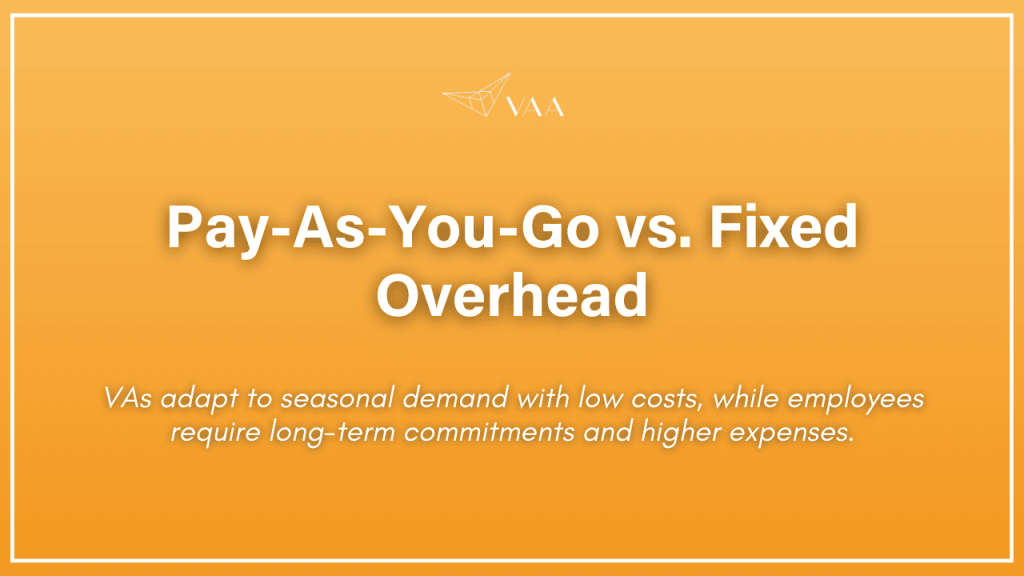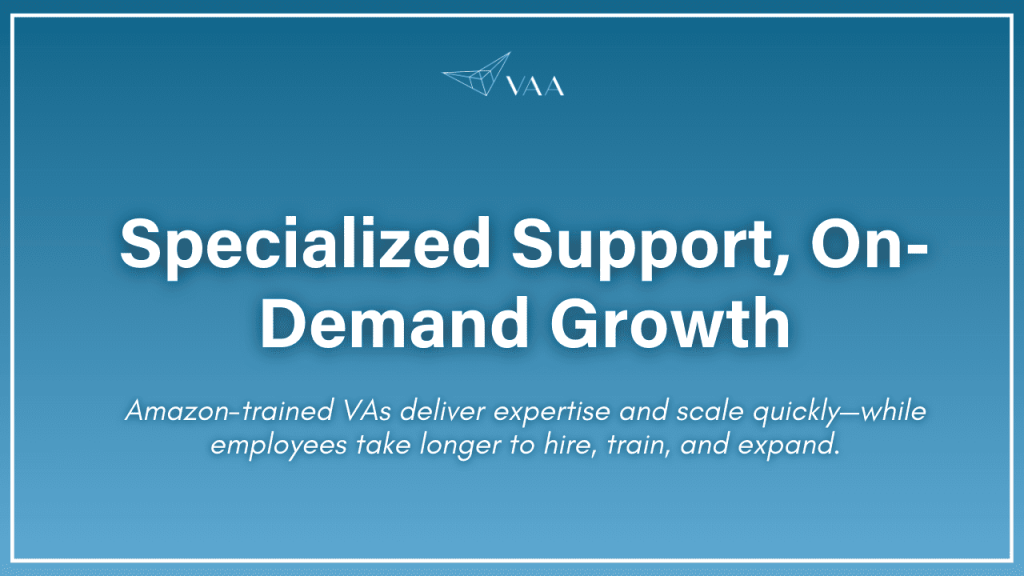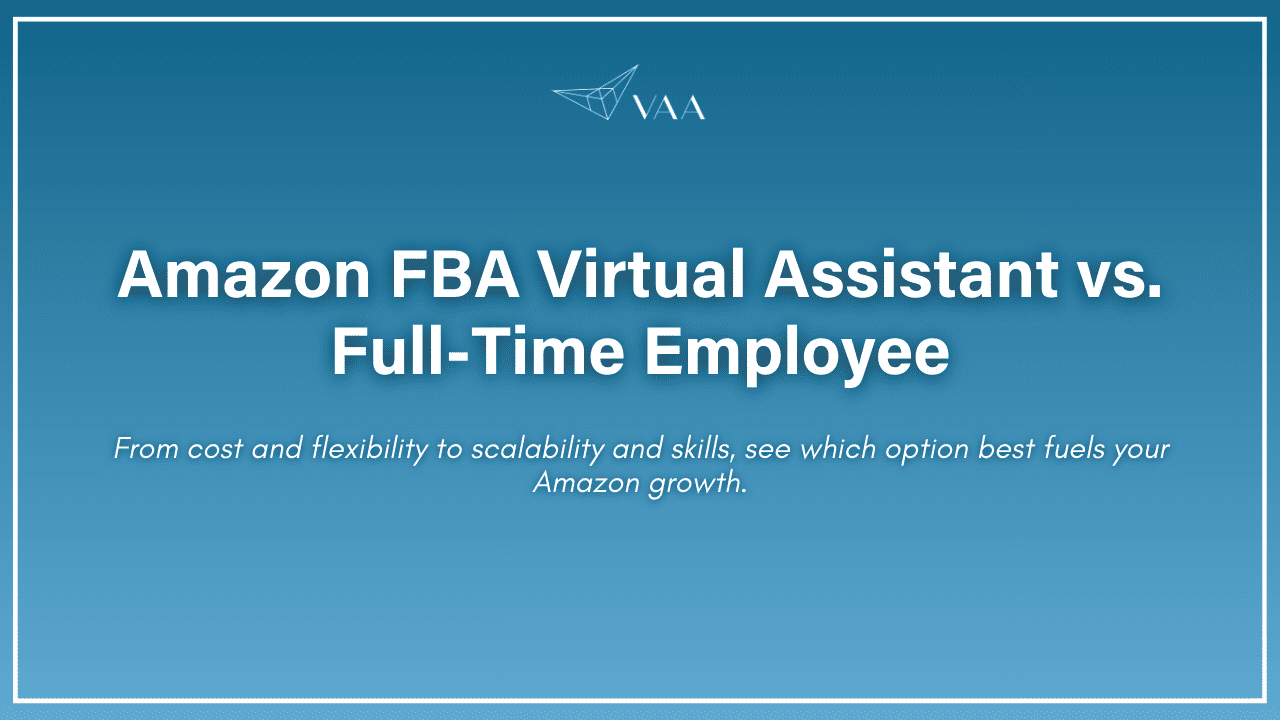As an Amazon FBA seller, you’ll eventually face a big decision: should you hire a full-time employee or outsource tasks to a virtual assistant (VA)? Both options can help you scale, but they come with very different costs, commitments, and benefits. Making the right choice can impact your bottom line, your workload, and even your long-term growth. To help you decide, we’ll compare
Amazon FBA virtual assistants and full-time employees across five key areas: cost & overhead, flexibility, skill set & specialization, scalability, and communication & control. While both sides have strengths, many sellers find the practical advantages of outsourcing to be hard to ignore.
1. Cost & Overhead: Fixed Expenses vs. Pay-As-You-Go
One of the clearest differences between full-time employees and VAs is cost. When you hire a full-time employee, you take on much more than a salary. Employers often spend 20–30% above base pay to cover payroll taxes, benefits like health insurance and retirement plans, paid leave, and equipment. Even for an entry-level role, this can quickly add up. In the U.S., for example, an e-commerce coordinator might earn $45,000 annually, but the true cost to the business could be closer to $55,000 after overhead.By contrast, hiring a
virtual assistant for Amazon FBA is far more cost-effective. VAs are independent contractors, so you pay only for the work you need, usually hourly or per project. Many Amazon VAs charge between $4 and $10 per hour if hired from popular outsourcing hubs such as the Philippines, or $15–$30 per hour for U.S.-based specialists. Since you don’t provide benefits or office space, the overhead drops dramatically.For Amazon sellers trying to keep margins lean, this pay-as-you-go structure is a major advantage. Employees can be worthwhile if you need full-time dedication and loyalty, but an FBA virtual assistant often wins out when cost efficiency is the priority.

2. Flexibility: Adaptability on Your Terms
Amazon businesses rarely run at a steady pace year-round.
Peak seasons like Prime Day, Black Friday, and Q4 can send orders surging, while other months may be relatively quiet. This uneven workflow makes flexibility a big deal.Virtual assistants shine here. Because they work remotely and usually freelance or contract, you can scale their hours up or down as needed. Need 30 hours a week in December but only 10 in January? That is easy to arrange. You can also hire a virtual assistant for Amazon FBA in different time zones, which allows your business to operate almost around the clock. This is particularly useful if you’re managing multiple marketplaces.Employees, however, are generally tied to fixed schedules. A full-time worker will expect steady hours, and reducing their workload during slow months is not always possible. If you want seasonal support, you would need to go through temporary hiring processes, which take time and effort.For sellers who value adaptability, an FBA virtual assistant provides a more agile workforce, ready to match your business’s shifting demands.
3. Skill Set & Specialization: Global Experts vs. Local Generalists
The type of expertise you need also matters. Many Amazon FBA virtual assistants specialize in e-commerce tasks such as product research, listing optimization, PPC management, customer service, and inventory tracking. Since they often work with multiple Amazon sellers, they already know how to use tools like
Helium 10, Jungle Scout, or Seller Central. This means they can start contributing with little to no training.By comparison, a new employee may bring broader skills but might lack direct Amazon experience. Training them on platform-specific tools and best practices can take weeks or months. In-house staff often become generalists who handle a wide variety of tasks but may not have deep expertise in areas like advertising campaigns or keyword optimization.Outsourcing also expands your access to the global talent pool. For example, the Philippines has become one of the top destinations for skilled e-commerce VAs, thanks to strong English proficiency and specialized training programs. VAA Philippines is one such agency that screens and trains VAs specifically for Amazon FBA tasks, with rates starting around $5.50/hour. This illustrates how outsourcing a virtual assistant for Amazon FBA can deliver specialized support at a fraction of the cost of hiring locally.
4. Scalability: On-Demand Growth vs. Slower Expansion
Scaling is another area where VAs tend to stand out. If your Amazon business suddenly grows, maybe a new product goes viral or you expand into Europe, you can bring on additional VAs quickly. Agencies and freelance platforms often have ready talent pools, so you could go from one assistant to three within a week. When sales dip, scaling back is equally simple.Employees, on the other hand, require longer lead times. Hiring, onboarding, and training each new staff member is a process that can take months. You’ll also need to consider permanent payroll commitments and possibly more office space or equipment. Scaling down is even harder. Layoffs are expensive and disruptive, and keeping underutilized employees drains resources.For businesses experiencing rapid growth or seasonal spikes, the ability to
scale up and down with ease makes an FBA virtual assistant a highly practical choice. Employees may be better once operations are large and stable, but for agile sellers, outsourcing provides the elasticity needed to keep pace with market changes.

5. Communication & Control: Remote Collaboration vs. Hands-On Oversight
Communication and control are often where sellers feel the most difference. With a VA, most collaboration happens through digital channels such as email, Slack, project management tools, or Zoom. This works well if you establish clear processes and SOPs, but it can take extra effort to overcome time zone gaps or cultural differences. Without daily face-to-face contact, some sellers feel they have less direct oversight.Employees, by contrast, provide immediate, in-person communication if they’re local or working on the same schedule. You can call a quick meeting, provide instant feedback, and monitor work more closely. In-house staff also tend to integrate more into company culture, which can foster loyalty and shared commitment.That said, many Amazon sellers successfully manage remote teams by setting clear expectations and holding regular check-ins. Tools like Asana or Trello make it easier to track tasks, while SOP documents help ensure consistency. In practice, an FBA virtual assistant can be just as reliable as employees if you invest in proper communication systems.
Growing Your Business With VAA Philippines
So, which is better for your Amazon FBA business, a virtual assistant or a full-time employee? The answer depends on your priorities. Employees offer consistency, cultural integration, and hands-on oversight. But they come with higher costs, longer commitments, and less flexibility. Virtual assistants, on the other hand, provide lower costs, flexible scheduling, specialized skills, and faster scalability. For many Amazon sellers, especially those in growth mode or managing fluctuating demand, outsourcing delivers the most practical balance of efficiency and affordability.It does not have to be an all-or-nothing choice. Some sellers combine the two approaches, keeping one or two in-house employees for core operations while delegating specialized or seasonal tasks to VAs. Agencies like
VAA Philippines show how outsourcing a virtual assistant for Amazon FBA connects sellers with trained specialists who are ready to plug into business operations at a fraction of the cost of hiring locally. Ultimately, the right setup is the one that helps you stay focused on growth while keeping costs under control. For most Amazon sellers, the flexibility and efficiency of working with an FBA virtual assistant make outsourcing a smart, strategic move.


